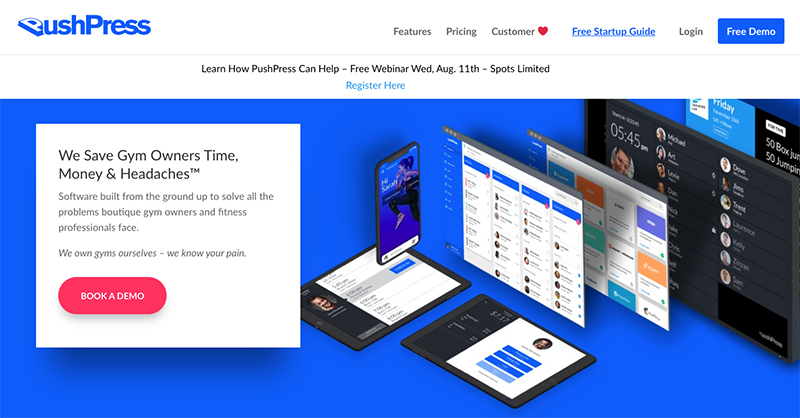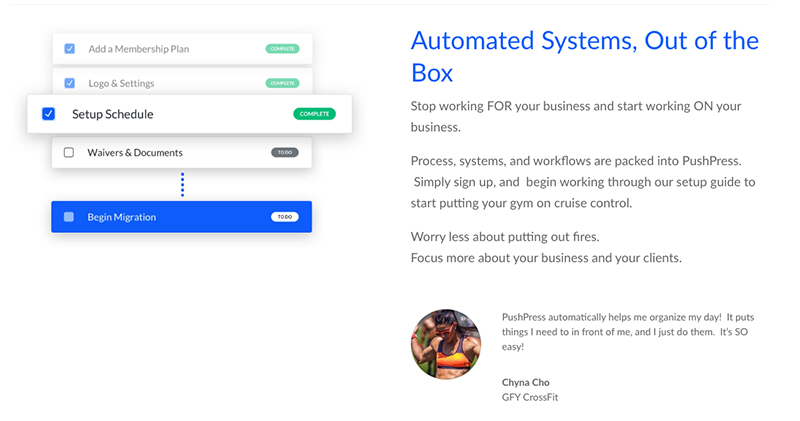Hey everyone, I'm Dan Uyemura, CEO of PushPress. I used to own a couple of gyms and realized how far out of touch the business management platforms were, so I formed a team of tech-centric gym owners and we built PushPress to fill the gap.
PushPress is a modern boutique fitness business management platform. We help gyms manage and grow their business by helping them organize, automate, and delegate efficiently.
We've long held the stance that in today's day and age, every business — even brick and mortar gyms — need a tech stack. The list below is what I've narrowed down to the best, most important SaaS products we use. It's not even everything! As a company one of our core tenets is that the concept of an "all-in-one" is flawed. This list illustrates that point pretty clearly, in my opinion.

Our Dev Stack
These are the key tools in our development stack. While most people think of a dev stack strictly from the engineering end of things, I'm also including some key pieces on the billing and product end that are essential to all development practices and direction at PushPress.
-
AWS: Our cloud server architecture.
-
Stripe: For recurring billing, credit card tokenization, and management. Because billing is so integral to everything we do, I'm including it in the dev stack. We not only bill our clients using Stripe but we also built our entire platform on top of Stripe Connect, which allows our clients to bill their customers. We were one of the first Stripe Connect platform clients back in 2012, and it might have been the best decision we made. Stripe enabled us to focus on our core business objectives and challenges while allowing them to focus on the ever-changing landscape of international payments.
-
ERN: Our staples are Express/React/Node.js. Database-wise, we choose the best tool for the job: Aurora, Redshift, Dynamo, Elasticsearch, Firehose, or whatever else is best suited to solve our analytics, data storage, or retention needs.
-
Datadog: As a data-driven organization, we like to make sure we have data to back up our ideas. Datadog provides a key centralized location for this. From weekly retrospective calls to operational excellence reviews to proactively monitoring abnormalities, Datadog helps us keep things afloat and running smoothly.
-
Sketch: The fastest way to take an idea from product concept to developer handoff. Our product team can go from wireframe to prototype with assets and specs about 20x faster than the old Photoshop/Illustrator combo.
-
Docker: Docker has allowed us to deliver the exact same development environment to our developers and our different server locations without fail. Setting up a new developer environment went from a full day of sitting side by side with a dev to sending them quick self-serviced directions.
-
Bamboo: Being able to automate testing of our code and the delivery of code to servers is key to delivering fast customer value in a scalable, safe and consistent manner.
-
Github: A rigorous requirement of Peer Review of code commits has saved us from stupid mistakes and subsequently made our engineers better at the same time — enabled by GitHub.
The Obvious
Everyone likely uses these (or a competitor) because the value is clear and obvious — but they're so integral to our operations I have to include them. These are a must-have starter set of SaaS products to start your business against.
-
Google for Business: Ubiquitous, well supported, and feature-rich core business tools like email, calendaring, documents, sheets, and meetups.
-
Hubspot CRM: A free and pretty-damn-good CRM to manage your sales pipeline and contacts. We picked up the Sales Pro upgrade pretty quick to unlock a lot of sales automation features.
-
Slack: Running a distributed, remote team requires solid team communication. Slack's core competencies and apps meet almost all of our communication needs. Slack calls and desktop sharing make pair coding and engineering calls a breeze as well.
-
Intercom: A solid in-app support system is the center point of our customer success. We use almost their entire platform: support, automated messages, tours, lead generation, and bots to assist our team in delivering the best customer experience as possible.
-
Zapier: This is an absolute requirement for us, as it glues together every platform we use or would consider using.
-
Xero: Our accounting software. Super unsexy, but I think too many startups don't worry about cash flow and accounting enough.
-
Zoom: Zoom is great not only for internal collaboration, but as a sales and marketing tool as well. It's become the de facto video conference system for most platform SaaS sales on the Internet, including ours. Our customer success team uses Zoom to hold weekly success-oriented webinars as well.
-
Acuity Scheduling: Booking times for sales and customer success calls is an absolute must for our business, and we found Acuity to be the best for us. We've tried many, and as much as I wished daily that Hubspot Meetings would do the trick, it simply isn't as robust as Acuity in key areas we need (such as round robin team scheduling).

The Awesome / Obscure
These SaaS products are deeply embedded in our stack, but might not be relevant to early-stage startups or as obvious as the list above.
-
Skitch and Loom: Putting both of these on the same line, as they solve the same problem in different ways. Generally speaking, there are many times we need to quickly and succinctly describe problems or requests of our team, and a screenshot with the caption "WTF" and an arrow pointing to a potential problem often conveys it all. Both reduce the friction of complex communication dramatically.
-
Profitwell: Understanding your core financial numbers are growth are imperative regardless if you're trying to build a bootstrapped business or if you're trying to fundraise. Profitwell plugs directly into most major modern billing stacks and will give you a wealth of information automatically. If you haven't turned this on and you're generating revenue, sign up immediately.
-
FullStory: Understanding your client journey — good and bad — is key to delivering client success. Fullstory has allowed us to troubleshoot customer issues with full context, being able to see their exact usage (not what they recall and recite to our team). It also allows us to quantify UI/UX changes and design pitfalls (rageclicks, anyone?).
-
Process St.: As you grow your business, nothing is more important than moving tribal knowledge into documented, repeatable processes. Process St. is a game-changer when you get to the point where you need to hire help to perform repeated actions (customer onboarding, first 100 day experience, customer churn, etc). IMO, it's best to document and refine these processes even if you're a one-person shop, so once you're ready to hire, you have it all ready to go.
-
Wootric: Once you get an established client base, you need to continually take their pulse to make sure you're doing a great job for them. There are several NPS-like systems out there, Wootric has been our go-to from day one. Our customer success team is evaluated weekly on our trailing 30-day NPS to make sure we're delivering excellence worthy of telling a friend about.
Advice and learnings for other indie hackers
No matter how you cut it and regardless of what industry you're in, you will likely be working in 20+ software platforms to help enable you to win. All-in-ones are clunky and too horizontally distributed to effectively perform any serious job function at a high level (see our choice of Acuity Scheduling over Hubspot Meetings, even though I secretly wish Hubspot could do the job better every single day). Even if an "all-in-one" builds the features you seek, iterating and continuously making them better requires exponentially more effort.
Get used to the idea you'll be learning and living in dozens of apps. Find ones that work together — and if not together, at least with Zapier. Learn how to make them work together as best as they can, and adjust your business processes around what's made possible by the software you pick.

Nice! I have founded www.joinsecret.com to help founders access big savings on their favorite tools. :)
just had a look, pretty cool.
Thanks Alexandre ;) Feel free to share, it's free
Wholesale gym equipment at low price from china suodunfitness
https://www.suodun-fitness.com
Be the star of your own life. Make yourself beauty inside and out!
Make up is a tool that is seen by many as a form of self-expression. With the growth of cruelty-free makeup brands, people have started relying on makeup more. Nowadays women and men are equally using makeup and the market for cosmetics has seen a rapid progression. Makeup has chemical properties and not every cosmetic company uses organic ingredients.
more info at https://www.realjamescharles.com/
<a href="https://neleus.com/" target="_blank">Gym Wear</a>
The most important thing about wearing sports gear is it improves your performance. Sportswear manufacturers go out of their way to discover which kinds of textures and materials are good for specific sports. This gym wear will improve your skills. https://neleus.com/
"Gym Fitness Equipment:
Yanre Fitness Self-design Gym Equipment Expert For 24 years https://www.yanrefitness.com/.
"
What do u guys use for acquisition/retention analytics ?
My former leader, who founded a successful startup (Channable), told me it doesn't really matter which stack you pick to start with because, in the beginning, the most important thing is to get costumers and that the most likely thing to happen - if you succeed to get customers - is that you will have to rewrite most of the code anyway after one or two years. That made a lot of sense to me, who would be more tempted to overthink that step and get paralyzed trying to find the perfect technology to solve a problem.
to some degree this is correct. This stack you see here isn't what we started with.
I think your boss meant more the code/tech stack, not the saasStack, however. Some aspects of your saasStack will be tightly integrated with your code/product (like auto moving deals in hubspot, etc). And some aspects will be very/completely independent (Google Email, Slack, etc.)
@danuyemura What did you start with?
By the way, awesome product (it's the product I contemplated building... probably a lot of crossfitters/entrepreneurs like me have thought the same, but you did it!).
I'm building/have built other stuff now, and I'm really interested in you fleshing out this paragraph in a post of its own:
"I used to own a couple of gyms and realized how far out of touch the business management platforms were, so I formed a team of tech-centric gym owners and we built PushPress to fill the gap."
The process of design, testing with users/a small group of first clients, partnering, then building the business to $100K/mo (and maybe beyond). The expectations, planning, struggle, things you learned that you didn't expect to, and the "mental game" of entrepreneurship.
I would love to talk to you personally about it, if I may connect with you.